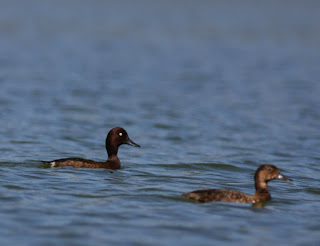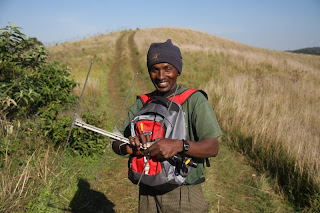After 75 days of travel we finally reached the Red Island and we were ready to start our two month stay here with a bang. You might have heard that the Madagascar Pochard has been rediscovered in 2006. The place where this ultra rare species has been rediscovered is located 42 km north of Bealanana and is now open for birders and not just for Birdquest. Before we started our journey we contacted Sam of the Peregrine Fund (sam_theseing@yahoo.fr) to arrange our visit to the lakes where the ducks are found. This place can be reached in three different ways: by 4WD (almost everybody uses this way), by motorbike and on foot. Of course we opted for the latter and it turned out that we were the first Vazaha's ever to walk the entire 42 km.
We stocked up in Antananarivo for this mini expedition and our food included: 1 kg of rice, 0.5 kg of pasta, 2 packs of noodles, 1 bottle of Ketchup, 6 cans of tomatoes, 0.5 kg of mushrooms, 0.5 kg of sweet corn, 0.5 of mixed vegtables, 7 packages of biscuits, 1 vanilla cake, 3 baguettes, 1 cheese and 1 kg of carrots. We filtered our own water with the UV filter we carry, but the camp at the lakes has filtered water as well.
After 24 hours of tiring taxi-brousses we finally reached Bealanana and there we got picked up by Eugene (0325018013) who was going to accompany us during the hike. The entire 42 km took us about 10 hours,even with the 30 kg of luggage and we added another 3 kg of beer to our luggage in Bemanevika, the last village before the lakes. During the walk we could add some good endemics already to our list including: Malagasy Harrier, Madagascar Partridge, Harlequin Quail, (Madagascar) Cuckoo Roller, Madagascar Fody and Madagscar Mannikin. In the camp we drank one of the most well earned beers of hour life and fell into a deep sleep, ready for the next day and what a day it would be!
 |
| White-throated Rail Juvenile (Dryolimnas cuvieri) |
The next day we enjoyed our breakfast in the camp which is situated in Sambirano (transitional) forest and saw already lots of birds like White-throated Rail, Madagscar Cuckooshrike and some pure (!) Forest Fodies. After a short walk through the plains we reached another patch of forest which surrounded the Madagascar Pochard Lake. Here we saw Madagscar Flufftails, Spectacled Tetraka (take care not to identify the subspecies that occurs here as Dusky Tetraka, for it looks a lot like the drawing in Sinclair and Langrand, but that one is completely wrong), Pitta-like Ground Roller, Stripe-throated Jery and Nelicouri Weaver. Once we reached the lake we feasted our eyes on at least 30 Madagascar Little Grebes, dozens of Meller's Ducks, Singing Madagascar Swamp Warblers, a Madagascar Rail charging at us and in the end some Madagascar Pochards. What a shame they are so far away, we thought, and minutes later we were in a small kayak paddling towards the ducks. We enjoyed awesome views and we even found two Malagasy Pond Herons as a bonus!
 |
| Pitta-like Ground Roller (Atelornis pittoides) |
 |
| Madagascar Little Grebe (Tachybaptus pelzenii) |
 |
| Meller's Duck (Anas melleri) |
 |
| A pair of the critically endangered Madagscar Pochard (Aythya innotata) |
The next goal was a bit more difficult. We needed the help of Loukman (0331856009) to find the Madagascar Red Owl, that has been radio tagged. There used to be 7 owls radio tagged in this area, but six of them have a low battery and probably the one on this individual will run out soon, so better be quick to visit this site! One hour later we were standing in front of a 2 kj male Red Owl and we enjoyed incredible views with a Forest Rock Thrush as a bonus. Later we also enjoyed good views of Nuthatch Vangas in the same forest.
 |
| Loukman carrying the gear to locate the Madagascar Red Owl (Tyto soumagnei) |
 |
| 2 kj male Madagascar Red Owl (Tyto soumagnei) |
For the third target we headed to the third crater, which is not a lake but a swamp and it is definitely one of the best in entire Madagascar. Here we saw Malagasy Harrier, Madagascar Snipe and Grey Emutail, but unfortunately not our main target: Slender-billed Flufftail. Luckily we had another day. During the night we dried our equipment near the campfire while we listened to the Rainforest Scops Owls and Madagscar Long-eared Owls. The latter didn't want to show themselves unfortunately.
The next morning we return to the swamp en tried to find Slender-billed Flufftails at three different spots and in the end, after three hours searching I flushed a female and shortly after that we also heard a male calling! Ow yeah, another seldom seen species ticked and we even saw a Madagascar Crested Ibis and two Madagascar Rails as a bonus! If you are going to try for this species, please do this with extreme care, for many rare species breed in this swamp and the only other site for this species has a 6 meter wide path running through the marsh, caused by all the birding crews searching for the Flufftail... Also be careful with the snakes (which are here plentyful) and the razor sharp sedges here. After this triumph we returned happily to the camp and enjoyed another well earned beer.
 |
| Pair of Malagasy Harriers (Circus macrosceles) |
In the afternoon I went out with Loukman and Eugene to search for Velvet Asity, Common Sunbird Asity, Blue Coua, Red-fronted Coua and Red-headed Ground Roller, but we saw none of these. We saw only one single bird, but what a bird it was: Madagascar Serpent Eagle! This species used to be equally easy as the Red Owl, but the radiotags on the two Serpent Eagles here also have a low battery, making this bird the second hardest bird in Madagscar (after the mythical Dusky Tetraka). How unbelievably lucky we were to find one sitting in a tree next to the track! We enjoyed brilliant views of this cracker for at least an hour, thanks to Eugenes amazing ability to find the bird again as soon as it changed its perch. After this succes I exchanged hugs with both of my guides, for they both have been searching for this bird for 84 days straight without success and today they succeeded. Probably I am they only birder in the world who has seen Slender-billed Flufftail and Madagascar Serpent Eagle in the same day. Another extremely satisfying day ended with a beer and only smiling faces. What a day!
 |
| Madagascar Serpent Eagle (Eutriorchis astur) (female) |
The next day we headed back, partly on foot, partly on motorbike. We were sad to leave this magical place behind us, but one day we will return, even though we have ticked off almost everything at this site. I can highly recommend this site to everyone, it is probably our number one birding site until now.
 |
| The Madagascar Pochard Lake (picture made by Anna van der Kaaden) |
For a more elaborate Dutch version of this post, have a look at:
http://dutchbirding.nl/news.php?id=781



